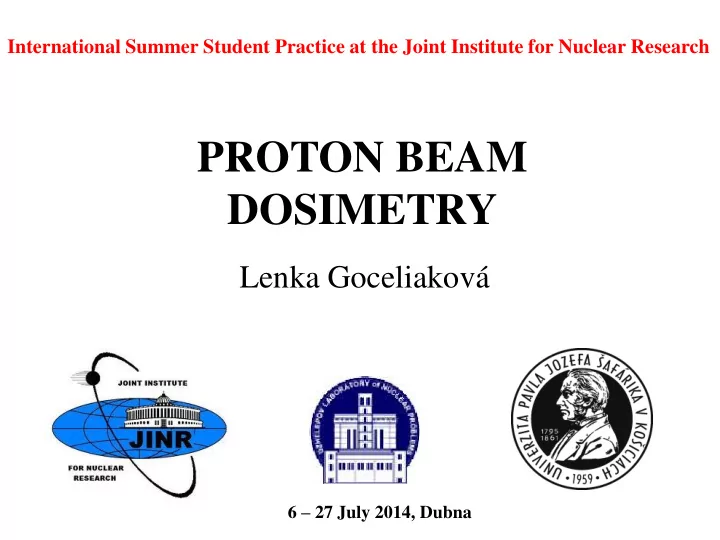

International Summer Student Practice at the Joint Institute for Nuclear Research PROTON BEAM DOSIMETRY Lenka Goceliaková 6 – 27 July 2014, Dubna
PROTON BEAM DOSIMETRY Project participant : Lenka Goceliaková University of Pavol Jozef Šafárik, Faculty of Science, Košice, Slovakia Supervisor: Dr. S.V. Shvidky Medico – Technical Complex, Dzhelepov Laboratory of Nuclear Problems, JINR, Dubna
AIM OF THE PROJECT • To verify the correspondence of the dose distribution in case of therapeutical proton beam, using film dosimetry and simulations in the 3D Treatment Planning System (TPS) • To compare the dose distribution obtained using EBT films and the 3D TPS • To compare EBT2 & new EBT3 films
Why do we need the dosimetry? • To verify the accuracy of a planning system calculation algorithm and to determine the distal dose for the volume.
Proton beam dosimetry • Measurements of the radiation dose 0,0001 Gy – 3 Gy Properties of the Gafchromic films: • EBT2, EBT3 • self developing dosimetry films When the active component is exposed to ionizing radiation, it reacts and forms a green colored polymer.
Materials and Methods • Irradiation EBT2 & EBT3 calibrate films(picture with the small pieces) • Irradiation EBT2 & EBT3 films • Scanning of films • Drawing of calibration curves • Calculation of the matrices for all films • Comparison of the dose distribution using EBT films dosimetry and the 3D TPS • Gamma – index calculation
Irradiation Method • The films were irradiated individually with protons in a water tank; • The proton beams pass through colimator, water tank and stops in radiochromic film; • Films were places in the water phantom and positioned with a angle 5 degrees slope to the beam axis in the horizontal plane
Films Scanning • Reflection Method : • light from the transmitter bounces off a reflector placed outside of the housing and travels back to the receiver. Positive Method : • a beam of light shines directly from the transmitter to the receiver. • An object is detected when it passes between transmitter and receiver and blocks the beam of light.
Calibration curve EBT3 – Positive Method 3,0 V Dose a b c 2,5 2,0 Dose (Gy) a -0,84095 1,5 b -34,25479 1,0 0,5 c 0,98165 0,0 V pixels 110 120 130 140 150 160 170 180 190 200 210 Value of pixel
Calibration curve EBT3 – Reflective Method V Dose a b c 3,0 2,5 0,12236 a 2,0 Dose (Gy) b -10,01656 1,5 c 0,95327 1,0 V pixels 0,5 0,0 10 20 30 40 50 60 70 80 90 100 110 120 130 140 Value of Pixel
Comparison between films and planning system Comparison between EBT2 (black) and Planning System (red) for Positive Method 90 80 dL=3mm; dD=3% 10 G <= 1 (10%): 80.8% 70 60 G <= 1 (20%): 72% 60 G <= 1 (30%): 59% Width(mm) 70 50 G <= 1 (40%): 11.5% 50 G <= 1 (50%): 71% 40 60 60 90 G <= 1 (60%): 98.6% 60 30 G <= 1 (70%): 100% 80 G <= 1 (80%): 99.4% 90 20 G <= 1 (90%): 99.7% 30 40 20 10 G <= 1 (100%): 100% G <= 1 (>90%): 99.7% 20 40 60 80 100 120 140 160 Depth(mm)
Comparison between EBT3 (black) and Planning System (red) for Positive Method 80 10 60 40 30 60 50 70 60 60 60 60 60 60 90 60 Width(mm) 50 70 50 60 60 30 70 40 70 60 60 60 60 70 60 30 80 70 dL=3mm; dD=3% 60 60 60 60 90 60 60 20 G <= 1 (10%): 90.4% 60 80 60 70 G <= 1 (20%): 73.6% 20 40 20 10 10 G <= 1 (30%): 58.8% G <= 1 (40%): 10.6% 20 40 60 80 100 120 140 G <= 1 (50%): 59.5% Depth(mm) G <= 1 (60%): 91.9% G <= 1 (70%): 99.6% G <= 1 (80%): 100% G <= 1 (90%): 100% G <= 1 (100%): 100% G <= 1 (>90%): 100%
Comparison between EBT2 (black) and Planning System (red) for Reflective Method 80 10 30 20 70 60 60 50 60 90 60 50 70 50 Width (mm) 50 40 40 50 50 40 70 30 dL=3mm; dD=3% 40 80 50 90 G <= 1 (10%): 59.3% 60 90 50 20 80 G <= 1 (20%): 80.3% 40 30 40 20 10 G <= 1 (30%): 93.9% G <= 1 (40%): 58.4% 20 40 60 80 100 120 140 G <= 1 (50%): 77.4% Depth(mm) G <= 1 (60%): 99.6% G <= 1 (70%): 97.8% G <= 1 (80%): 90% G <= 1 (90%): 80.6% G <= 1 (100%): 100% G <= 1 (>90%): 80.7%
Comparison between EBT3 (black) and Planning System (red) for Reflective Method 80 10 30 50 50 50 50 60 40 Width(mm) 90 60 50 50 dL=3mm; dD=3% 40 50 60 70 G <= 1 (10%): 67.5% 60 70 50 80 G <= 1 (20%): 72.2% 60 50 50 20 G <= 1 (30%): 87.1% 80 G <= 1 (40%): 95.8% 40 20 G <= 1 (50%): 99.5% 20 40 60 80 100 120 140 G <= 1 (60%): 93.5% Depth(mm) G <= 1 (70%): 96.1% G <= 1 (80%): 75.9% G <= 1 (90%): 71% G <= 1 (100%): 100% G <= 1 (>90%): 71.2%
RESULTS • Positive Method: G – index more 90% • Reflective Method: G – index less 90% • Preferable is positive method of scanning
Conclusions • Radiochromic films are accurate detectors for proton beam dosimetry • Measured date are consistent with the date from PS in the acceptable deviation (3%) • Results from G – index comply requierement for the planning of proton therapy
THANK YOU FOR YOUR ATTENTION ! Special thanks to: My project consultant: Konstantin Shipulin – Medico-Technical Complex, Dzhelepov Laboratory of Nuclear Problems, JINR, Dubna
Recommend
More recommend